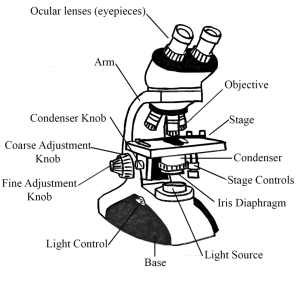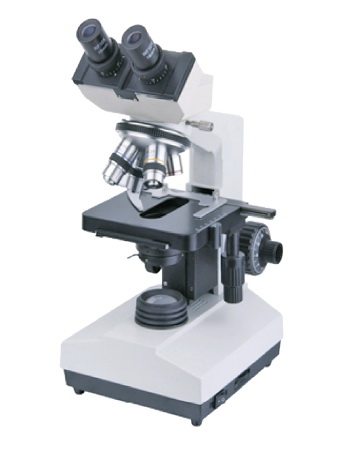Microscope
Microscope
A microscope is an instrument that produces enlarged image of small objects
Allowing the observer an exceedingly close view of minute structures at a scale convenient for examination and analysis
the most common microscope is the optical or light microscope in which glass lenses are used to form the image,
can be simple consisting of a single lens or compound consisting of several optical components in line.

Basic parts of a microscope
Head: Upper part of the microscope that houses the optical element of the unit
Base: The bottom of the microscope that it stands on
Arm: Structural element that connects the head of the microscope to the base.
Eyepieces: The eyepieces are the lenses at the top that the viewer looks through; they are usually 10X or 15X. To get the total magnification level, multiply the magnification of the objective used (ex: 10X eyepiece * 40X objective = 400X total magnification).
Tube: Where the eyepieces are dropped in. Also, they connect the eyepieces to the objective lenses.
Stage: The flat platform that supports the slides. Stage clips hold the slides in place. If your microscope has a mechanical stage, the slide is controlled by turning two knobs instead of having to move it manually. One knob moves the slide left and right, the other moves it forward and backward.
Illuminator: A steady light source that shines up through the slide. Mirrors are sometimes used in lieu of a built-in light. If your microscope has a mirror, it is used to reflect light from an external light source up through the bottom of the stage.
Nose piece: This circular structure is where the different objective lenses are screwed in. To change the magnification power, simply rotate the turret.
Objective Lenses: Usually you will find 3 or 4 objective lenses on a microscope. The most common ones are 4X (shortest lens), 10X, 40X and 100X (longest lens). The higher power objectives (starting from 40x) are spring loaded. Spring loaded objective lenses will retract if the objective lens hits a slide, preventing damage to both the lens and the slide. All quality microscopes have achromatic, parcentered, parfocal lenses. In addition, to get the greatest clarity at high levels of magnification, you will need a microscope with an Abbe condenser. Lenses are color coded and are interchangeable between microscopes if built to DIN standards.
Rack Stop: This feature determines how far up the stage can go. Setting the rack stop is useful in preventing the slide from coming too far up and hitting the objective lens. Normally, this adjustment is set at the factory, and changing the rack stop is only necessary if your slides are exceptionally thin and you are unable to focus the specimen at higher powers.
Condenser Lens: Condenser lenses focus the light that shines up through the slide and are useful for attaining sharp images at magnifications of 400X and above. If the maximum power of your microscope is 400X, a stage mounted 0.65 NA (or greater) condenser is ideal since it give you greater clarity without having to be focused separately. However, if your microscope goes to 1000X or above, focusable condenser lens with an N.A. of 1.25 or greater is needed. Most microscopes that go up to 1000X come equipped with an Abbe condenser, which can be focused by moving it up and down. The Abbe condenser should be set closest to the slide at 1000X and moved further away as the magnification level gets lower.
Diaphragm or Iris: The diaphragm or iris is located under the stage and is an apparatus that can be adjusted to vary the intensity, and size, of the cone of light that is projected through the slide. As there is no set rule on which setting to use for a particular power, the setting depends on the transparency of the specimen and the degree of contrast you desire in your image.
Type of microscope

The light microscope is the most common type of microscope. Electron or ultraviolet microscope are used for commercial purposes or advanced scientific experiments. You should buy a type of microscope that is well-suited for your application. Do not go for high magnification always.
Most of the light microscope application requires a magnification of less than 60X. Compound microscopes are needed for viewing smaller specimens, like blood samples, water specimens, etc. Stereo microscopes are needed to view bigger specimens like insects, rocks, leaves, bugs, etc.
Quality
You should make sure that the quality of construction and lens is good. A good quality microscope will have solid metal alloys and high-quality prisms.
Illumination

A high-quality pedestal microscope has halogen lighting. It produces a strong white light. Portable microscopes have LED ring lights. In special microscopes that are used in biological experiments, fluorescent light is used. Tungsten is used in the entry-level microscopes.
These are the main factors you should consider before buying a microscope. You should read reviews of various microscopes to learn more about the features of different microscopes. You should also compare the features of microscopes within your budget range and then pick up the best that matches your requirements.

How to buy a microscope
If you want an instrument that can provide you with crisp high quality images at high resolutions avoid microscopes with plastic component. Look for a microscope with a metallic body and all glass lenses., also make sure you purchase from a well established dealer who will be around to help you with any technical problem.
Alpha surgicals supplies ltd got you covered with all you need in terms of quality and affordable medical equipment

